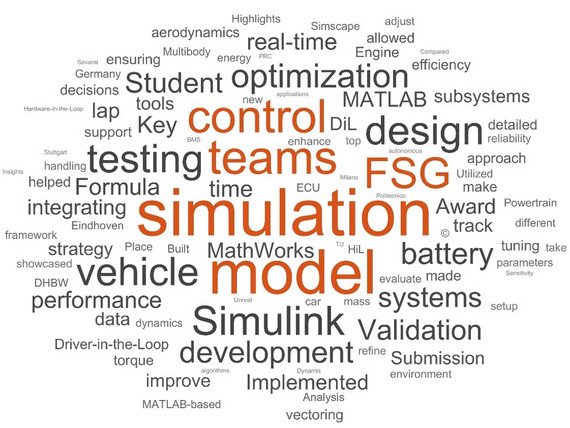At MathWorks, we have the privilege of seeing some of the most innovative student teams in the world push the boundaries of model-based design using MATLAB and Simulink. The FSG MathWorks Modeling & Simulation Award was introduced for the first time in 2024, and we were glad to receive 13 impressive submissions from teams showcasing their advanced simulation and modeling techniques. This award designed to recognize and reward teams that excel in utilizing MathWorks tools for the design of their electric and autonomous vehicles in the Formula Student Germany competition.
You can learn more about the 2024 award here:
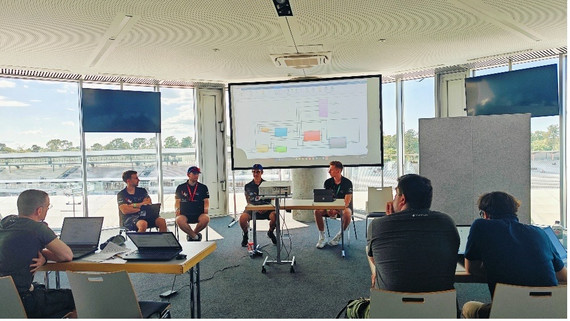
The 2024 competition showcased some of the best applications of simulation-driven engineering we’ve seen so far. The top teams used MathWorks tools for multiple applications that helped them to improve their vehicle design.
Let’s take a deep dive into what made them stand out and how their approaches can inspire Formula Student teams competing in 2025.
1st Place: Politecnico di Milano (Italy) - Dynamis PRC
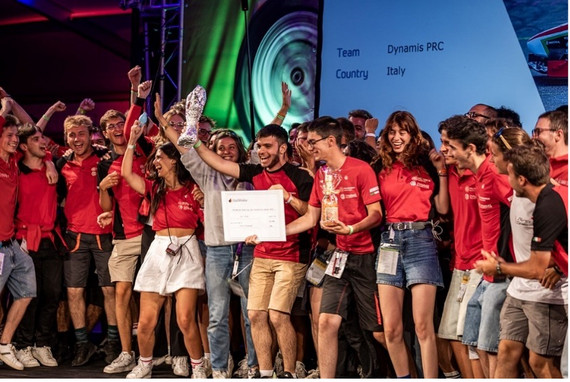
©FSG Partenfleder
Dynamis PRC from Politecnico di Milano showcased the use of real-time Driver-in-the-Loop (DiL) simulation to support vehicle development. Their simulation framework enabled them to test and refine their car virtually before on-track testing.
Key Highlights of Their Submission
- Multibody Simulation for Accurate Vehicle Modeling:
- Developed a full vehicle multibody simulation in Simscape Multibody, integrating suspension kinematics, aerodynamics, and tire dynamics.
- Modeled ride height-dependent aerodynamic maps to dynamically adjust downforce calculations.
- Incorporated control systems such as torque vectoring and traction control within the model for closed-loop testing.
- Driver-in-the-Loop (DiL) Simulator:
- Created an interactive DiL simulator that combines Simulink and Unreal Engine for a real-time driving experience.
- Integrated a steering interface and stateflow-based lap timing system to make testing more realistic.
- Developed a graphical interface and scene configuration to allow for rapid environment adjustments and visualization.
- Battery model and BMS design:
- Developed a battery pack model with a thermal simulation component to study temperature behavior and assess operational limits, alongside designing a battery management system (BMS)
- Real-Time Data & Performance Insights:
- Implemented Wi-Fi-enabled telemetry for instant feedback and live monitoring of key vehicle parameters.
- Scalability & Extensibility:
- Built their simulator using modular MATLAB projects, making it easy to add and test new subsystems.
2nd Place: TU Eindhoven (Netherlands) - University Racing Eindhoven
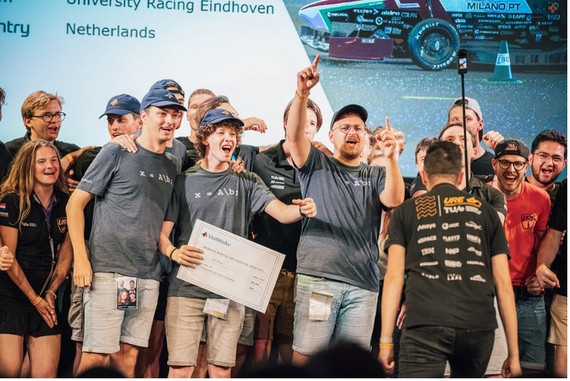
©FSG Wintermantel
The team from TU Eindhoven showed us just how far fidelity modeling and data-driven optimization can take a Formula Student car. Their approach combined multi-level vehicle modeling with lap time optimization techniques, ensuring they made data-backed design decisions every step of the way.
Key Highlights of Their Submission
- Vehicle Modeling:
- Used two-track, single-track and point mass models in a cascaded controller design for online implementation. This allowed them to start with quick simulations for high-level decisions and then move to detailed two-track simulations for fine-tuning dynamics.
- Lap Time Optimization & Sensitivity Analysis:
- Developed a MATLAB-based convex optimization framework to optimize vehicle parameters such as battery capacity, gear ratios, and aerodynamics.
- Conducted a sensitivity analysis to understand how factors like mass, downforce, and drag affected performance.
- Used simulated track data to adjust energy usage and powertrain efficiency.
Control Design & Tuning:
Implemented a multi-layered control strategy, including torque vectoring, and velocity control, for improved handling.
Implemented model predictive control to enhance reference tracking leading to decrease in lap time.
Designed an ECU architecture that integrates MATLAB-based simulation and real-time testing.
Utilized Simulink for rapid prototyping of control algorithms, ensuring efficient tuning before track deployment.
- Powertrain & Battery Innovation:
- Built a Simulink-based thermal model for predicting battery temperature and designing more efficient cooling options.
- Utilized Simscape Battery to model and analyze cell-level performance and scale it to full battery pack model using Simscape Battery.
- Validation & Next Steps:
- Compared simulation results against real-world track data, ensuring models aligned with physical testing.
- Planned to integrate a new ECU for even better vehicle control and optimization.
3rd Place: DHBW Stuttgart (Germany) - DHBW Engineering
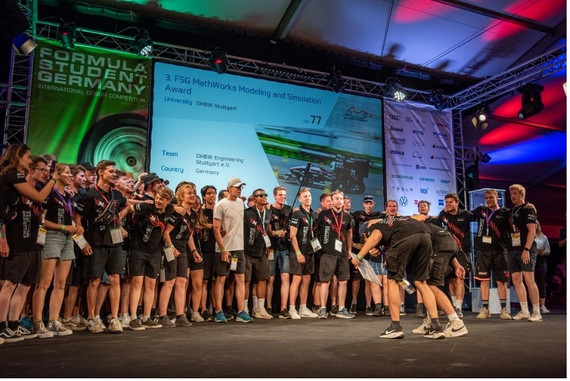
©FSG Cao
DHBW Stuttgart focused on Hardware-in-the-Loop (HiL) testing, allowing them to validate their control strategies in a realistic, closed-loop environment before implementation. This approach helped them streamline development, improve reliability, and optimize system performance.
Key Highlights of Their Submission
- Control Systems & Torque Vectoring:
- Implemented a new torque vectoring strategy to enhance vehicle handling and stability whilst optimizing for perfect usage of each wheel.
- Used MATLAB to optimize traction control, power distribution, and energy efficiency.
- Hardware-in-the-Loop (HiL) & Software-in-the-Loop (SiL) Testing:
- Developed a robust testing framework to validate control algorithms before deploying them on the car.
- Ensured seamless integration between different vehicle subsystems.
- Used CICD to automatically validate software and run checks
- Lap Time Simulation & Performance Analysis:
- Built a MATLAB-based lap time simulation tool to refine strategy, vehicle setup and design decisions.
- Validated simulation with sensor-based data to improve accuracy and find compliance in the suspension and other systems.
- Autonomous Driving & Powertrain Improvements:
- Used MATLAB for motion control, inverter software and state estimation
Key Lessons for 2025 Teams
We will be soon publishing the details of the FSG MathWorks Modeling and Simulation Award 2025. If you’re interested to participate, there’s a lot to learn from this year’s top teams. Here are a few key takeaways:
- Simulation is key for sizing and selecting vehicle components
- Several teams used their simulation models early in the design process to support critical decisions like motor selection, accumulator sizing, and aerodynamic setup. Teams ran parameter sweeps and optimization routines to evaluate trade-offs—balancing mass, energy consumption, and performance.
- Use of multi-fidelity models and variant subsystems for flexibility
- Several teams structured their simulations to support multiple levels of model fidelity—ranging from simple models for quick evaluations to more detailed representations for final validation. The use of variant subsystems in Simulink allowed teams to switch between different model configurations without rebuilding the entire simulation.
- Validation with test data strengthens model reliability
- Validation was a common thread across strong submissions. Teams worked to compare simulation results with measurements from track tests, dyno runs, or HiL setups. This effort gave teams more confidence in their models and made simulations a reliable tool for making design changes or tuning control strategies.
- Real-Time and Driver-in-the-Loop simulations support development and testing
- Driver-in-the-Loop (DiL) simulators and real-time simulations are becoming valuable tools for teams. Milano’s work on integrating their DiL simulator with Unreal Engine and real-time controls showed how virtual testing environments can be used not just for model validation but also for driver training and evaluating control systems.
- MATLAB and Simulink Help teams manage complex systems
- Teams used MATLAB and Simulink as central platforms to handle control development to battery modeling and optimization. This helped maintain consistency across subsystems and made it easier to scale models or generate production-level code for ECUs or FPGA-based systems when needed.
We invite student teams to take inspiration from this year’s participants and explore how modeling and simulation can enhance their designs. As you prepare for 2025, refining your simulation approach early can make a real difference in performance and development.
Stay tuned. We will soon publish the details for the 2025 award. In case of any questions, please reach out to Veer Alakshendra (valakshe(at)mathworks.com).

